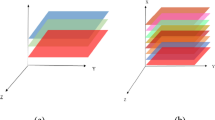Abstract
Development in the field of computer-aided learning and testing have stimulated the progress of novel and efficient knowledge-based expert systems that have shown hopeful outcomes in a broad variety of practical applications. In particular, deep learning techniques have been extensively carried out to identify remote sensed data obtained by the instruments of Earth observation. Hyperspectral imaging (HSI) is an evolving area in the study of remotely sensed data due to the huge volume of information found in these images, which enables better classification and processing of the Earth’s surface by integrating ample of spatial and spectral features. Nevertheless, because of the high-dimensional data and restricted training samples available, HSI presents some crucial challenges for classification of supervised methods. In particular, it addresses the problems of spectral and spatial resolution, volume of data, and model conversion from multimedia images to hyperspectral data. Various deep learning-based architectures are currently being established to solve these limitations, showing significant results in the analysis of hyperspectral data. In this paper, we deal primarily with the hyperspectral datasets, the dimensionality curse problem, and methods for classifying those datasets using some deep neural networks (DNN), especially convolutional neural networks (CNN). We provide a comparative analysis of various dimensionality reduction (DR) and classification techniques used for finding accuracies based on the datasets used. We also explore certain hyperspectral imaging applications along with some of the research axes.
Access this chapter
Tax calculation will be finalised at checkout
Purchases are for personal use only
Similar content being viewed by others
Reference
M.A. Ponti, L.S.F. Ribeiro, T.S. Nazare, T. Bui, J. Collomosse, “Everything you wanted to know about deep learning for computer vision but were afraid to ask.” 30th SIBGRAPI Conference on Graphics, Patterns and Images Tutorials (2017)
M.E. Paoletti, J.M. Haut, J. Plaza, A. Plaza. “Deep learning classifiers for hyperspectral imaging: a review.” ISPRS J. Photogrammetry Remote Sens 158 (2019)
M.J. Khan, H.S. Khan, A. Yousaf, K. Khurshid, A. Abbas, Modern trends in hyperspectral image analysis: a review. IEEE Access 6, 14118–14129 (2018)
M.S. Kim, S.-I. Tu, K. Chao, “Sensing for agriculture and food quality and safety.” Proceedings of SPIE—The International Society for Optical Engineering (2009)
X. Li, K. Liu, X. Zhang, “Advanced spatial data models and analyses.” Geoinformatics 2008 and Joint Conference on GIS and Built Environment (2009)
Y.-T. Chen, “Medical image segmentation using independent component analysis-based kernelized fuzzy c-means clustering.” Hindawi, Mathematical Problems in Engineering (2017)
N. Audebert, B. Saux, S. Lefevre, Deep learning for classification of hyperspectral data: a comparative review. IEEE Geosci Remote Sens Mag, IEEE 7(2), 159–173 (2019). https://doi.org/10.1109/MGRS.2019.2912563
A. Santara, K. Mani, P. Hatwar, A. Singh, A. Garg, K. Padia, P. Mitra,“BASS net: band-adaptive spectral-spatial feature learning neural network for hyperspectral image classifification.” IEEE Trans. Geosci. Remote Sens. 55(9) (2017)
X. Zhang, T. Wang, Y. Yang, “Hyperspectral images classification based on multi-scale residual network.” (2020)
W. Zhao, S. Du, “Spectral–spatial feature extraction for hyperspectral image classifification: a dimension reduction and deep learning approach.” IEEE Trans. Geosci. Remote Sens. 54(8) (2016)
https://towardsdatascience.com/dimensionality-reduction-for-machine-learning-80a46c2ebb7e
L.M. Bruce, C.H. Koger, J. Li, “Dimensionality reduction of hyperspectral data using discrete wavelet transform feature extraction.” IEEE Trans. Geosci. Remote Sens. 40(10) (2002)
“Pattern recognition and image analysis”. Springer Science and Business Media LLC (2015)
A. Fejjari, K.S. Ettabaa, O. Korbaa, “Chapter 12 feature extraction techniques for hyperspectral images classification.” Springer Science and Business Media LLC (2021)
J. Khodr, R. Younes, “Dimensionality reduction on hyperspectral images: acomparative review based on artificial datas.” 4th International Congress on Image and Signal Processing (2011)
S. Lin, W. Chan, J. Li, Z. Cai, “Liquid chromatography/mass spectrometry for investigating the biochemical effects induced by aristolochic acid in rats: the plasma metabolome.” Rapid Communications in Mass Spectrometry (2010)
A. Khan, I. Kim, “Sparse independent component analysis with interpolation for blind source separation.” 2nd International Conference on Computer, Control and Communication (2009)
A. Khana, I. Kim, S.G. Kong, “Dimensionality reduction of hyperspectral images using kernel ICA.” Proceedings of SPIE—The International Society for Optical Engineering (2009)
R. Hang, Z. Li, Q. Liu, P. Ghamisi, S.S. Bhattacharyya, “Hyperspectral image classification with attention aided CNNs.” arXiv:2005.11977v2 [eess.IV] (2020)
X. Liu, Q. Sun, Y. Meng, M. Fu, S. Bourennane, Hyperspectral image classification based on parameter-optimized 3D-CNNs combined with transfer learning and virtual samples. Remote Sens. 10, 1425 (2018). https://doi.org/10.3390/rs10091425
Y. Li, H. Zhang, X. Xue, Y. Jiang, Q. Shen, “Deep learning for remote sensing image classification: a survey.” WIREs Data Mining and Knowledge Discovery published by Wiley Periodicals, Inc (2018)
P.S. Bond, K.S. Wilson, K.D. Cowtan, “Predicting protein model correctness in using machine learning.” Acta Crystallogr Sect D Struct Biol (2020)
M.E. Paoletti, J.M. Haut, J. Plaza, A. Plaza, “Neural ordinary differential equations for hyperspectral image classification.” IEEE Trans. Geosci. Remote Sens. (2020)
Acknowledgements
The authors would like to thank the Pursue’s university MultiSpec site through which the Indian Pines dataset was available, and Prof. Paolo Gamba from the Telecommunications and Remote Sensing Laboratory for providing the Pavia University ROSIS dataset. The authors also gratefully acknowledge the helpful comments and suggestions of the associate editors and reviewers, which have improved the quality of the presentation.
Author information
Authors and Affiliations
Corresponding author
Editor information
Editors and Affiliations
Rights and permissions
Copyright information
© 2021 The Author(s), under exclusive license to Springer Nature Singapore Pte Ltd.
About this chapter
Cite this chapter
Swain, S., Banerjee, A., Bandyopadhyay, M., Satapathy, S.C. (2021). Dimensionality Reduction and Classification in Hyperspectral Images Using Deep Learning. In: Bandyopadhyay, M., Rout, M., Chandra Satapathy, S. (eds) Machine Learning Approaches for Urban Computing. Studies in Computational Intelligence, vol 968. Springer, Singapore. https://doi.org/10.1007/978-981-16-0935-0_6
Download citation
DOI: https://doi.org/10.1007/978-981-16-0935-0_6
Published:
Publisher Name: Springer, Singapore
Print ISBN: 978-981-16-0934-3
Online ISBN: 978-981-16-0935-0
eBook Packages: Intelligent Technologies and RoboticsIntelligent Technologies and Robotics (R0)




